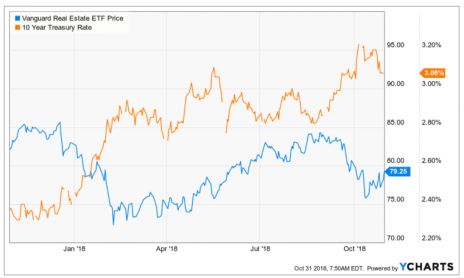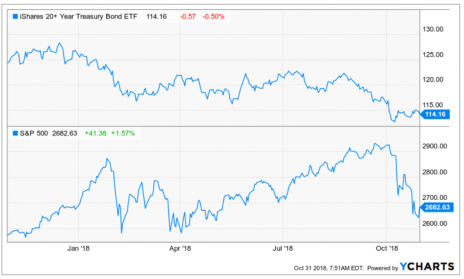With the stock market sliding downhill fast, not many stocks hit new highs this month. But a few did. Among them last week were Realty Income Corp. (O), Omega Healthcare Investors (OHI), National Retail Properties (NNN) and Equity Lifestyle Properties (ELS). All four are real estate investment trusts, or REITs.
Why are REITs doing so well while the market is tanking?
REITs and Rising Interest Rates
REITs are special purpose entities, with special tax status, that own real estate and pass along most of the income from that real estate to shareholders. REITs can own any type of real estate, but most specialize in one type, like apartment buildings, malls, medical office buildings or self-storage facilities. A REIT that owns property directly and gets most of its income from its tenants’ rents is called an equity REIT.
[text_ad]
A mortgage REIT, on the other hand, is a REIT that doesn’t own property directly. Instead, they own property mortgages and mortgage-backed securities. Their income comes from the interest they’re paid on the mortgages. They’re sometimes called mREITs. There are also hybrid REITs that own assets both ways.
Both types of REITs are exempt from taxation at the trust level as long as they pay out at least 90% of their income to investors, so they tend to have high yields. The four REITs mentioned above, O, OHI, NNN and ELS, yield 4.4%, 7.8%, 4.4% and 2.2%, respectively.
However, most REITs also have very high debt loads. They borrow heavily to invest in real estate, whether mortgages or properties. Mortgage REITs make their money on the spread between their borrowing cost and the interest rates on the mortgages they own, so they’re very sensitive to changes in interest rates. Equity REITs are less sensitive to interest rate changes, but still tend to be heavily indebted, so they still see their costs go up when interest rates rise. Better-capitalized REITs should be more insulated from rising interest rates, but the whole sector tends to get hit when rates spike.
That’s what happened in September and early October. The yield on the 10-year note rose from 2.85% to 3.23% in about five weeks, and REITs (as measured by VNQ, the most popular REIT ETF) dropped almost 10%.
However, the spike in the 10-year yield also triggered a market pullback (or at least contributed to it), which turned into a correction as October wore on.
When the stock market really starts to struggle, many, many investors seek the safety of treasury bonds. The rising demand for treasuries drives prices up and yields down. And so, following a spike in early October, the yield on the 10-year note has fallen back to around where it started the month.
So even though rising rates (among other things) contributed to the start of the market correction, rates have been falling as the correction has worsened. The iShares 20+ Year Treasury Bond ETF (TLT) bottomed on October 8, which was just the start of the correction for the stock market.
Lower yields mean REITs have to spend less on interest. They also make REITs’ high yields more competitive, since fixed income investments begin to yield less.
However, REITs are risky, so they often decline when investors begin seeking safety. Their outperformance during this correction suggests there’s something else going on as well.
One clue might come from the junk bond market.
What Junk Bonds Tell Us
Junk bonds have also been doing unusually well during the market rout. Although they’re part of the fixed income market, high-yield bonds also typically decline when investors get nervous, because they’re risky assets. Usually, junk bonds decline more than twice as much as the S&P 500 during market pullbacks of more than 5% (based on data from the past five years crunched by Bloomberg). But during this year’s two corrections, junk bonds losses have averaged 12% of equity declines.
That suggests that the equity market selloff may have been more about repricing certain growth-oriented assets—like the FANG stocks—than a wholesale, across-the-board reduction of risk. Of course, only time will tell.
*Note: This post is an excerpt from the October 31 issue of Chloe’s Cabot Dividend Investor issue. To read the rest of the issue, click here.
[author_ad]


